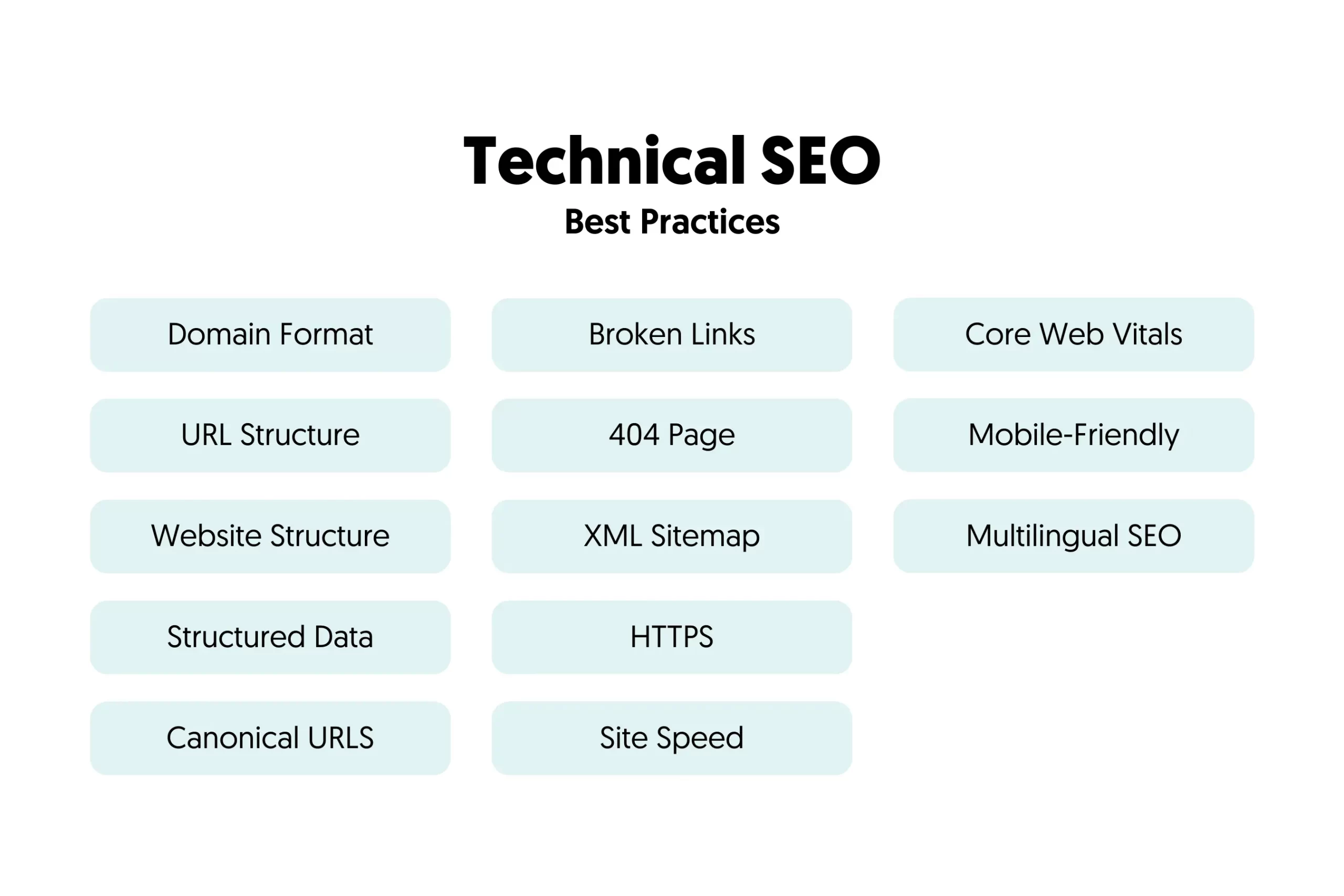- 1. Choose Your Domain Name Wisely
- 2. Conduct In-Depth Keyword Research
- 3. Analyze and Learn from Your SEO Competitors
- 4. Design a User-Friendly Site Structure and Navigation
- 5. Optimize Your Website’s Technical SEO
- 6. Develop a Strategic Content Marketing Plan
- 7. Create High-Quality, SEO-Optimized Content
- 8. Build an Engaged Community Around Your Brand
- 9. Boost Visibility with Off-Page SEO and Promotion
- 10. Track Performance, Analyze Data, and Improve Continuously
- Conclusion
Every successful website starts the same way, with zero traffic, little content, and no online presence. The difference between those that thrive and those that fade away is SEO.
By implementing the proper SEO tactics from the beginning, you set the foundation for long-term growth. Let’s explore the most effective steps to get your new website ranking.
1. Choose Your Domain Name Wisely
Your domain name is your website’s identity. It should be easy to remember, relevant to your brand, and SEO-friendly.
When choosing a domain, don't overcomplicate things, but think wisely. If you already have a name for your brand that is memorable and catchy, go for it.
If not, here are some key tips for choosing the right domain:
- Keep it short and simple – Avoid long or complicated names. A short, catchy domain is easier for users to remember and type.
- Use keywords if possible – If it makes sense, include a relevant keyword. This can help with SEO, but don’t force it.
- Stick with .com or .net if available – While other extensions work, .com or .net are the most trusted and recognized.
- Avoid numbers and hyphens – These make domains harder to remember and type correctly.
- Check availability and trademarks – Use tools like Namecheap or GoDaddy to see if your domain is available and ensure it doesn’t infringe on trademarks.
- Search Google to see what comes up - if similar brands or unrelated businesses dominate the results, you might want to choose a more unique name to stand out.
Once you have a domain, the next step is setting up your website. Your chosen platform affects how easily you can optimize your site for SEO.
WordPress is the best choice for most websites because it offers complete SEO control, thousands of plugins, and customization options.
If you’re launching an online store, Shopify is a solid alternative. Wix and Squarespace are beginner-friendly and sound options.
Equally important is choosing a reliable web host. A slow, unreliable host can hurt your site’s performance and rankings.
Look for a hosting provider with fast loading speeds, strong security, and good customer support. Some popular options include Bluehost and Knownhost.
2. Conduct In-Depth Keyword Research
After setting up your website, the next step is to find keywords for your homepage and content. In SEO, this process is called keyword research.
Keywords are words and phrases people use to search for information related to your business. These keywords help search engines understand your content and determine when to show your website in search results.
Keyword research is crucial for a new website. Since you don’t have authority or backlinks yet, targeting highly competitive keywords can be a waste of time.
Instead, focus on low-competition, long-tail keywords (longer, more specific phrases). These are easier to rank for and attract visitors genuinely interested in what you offer.
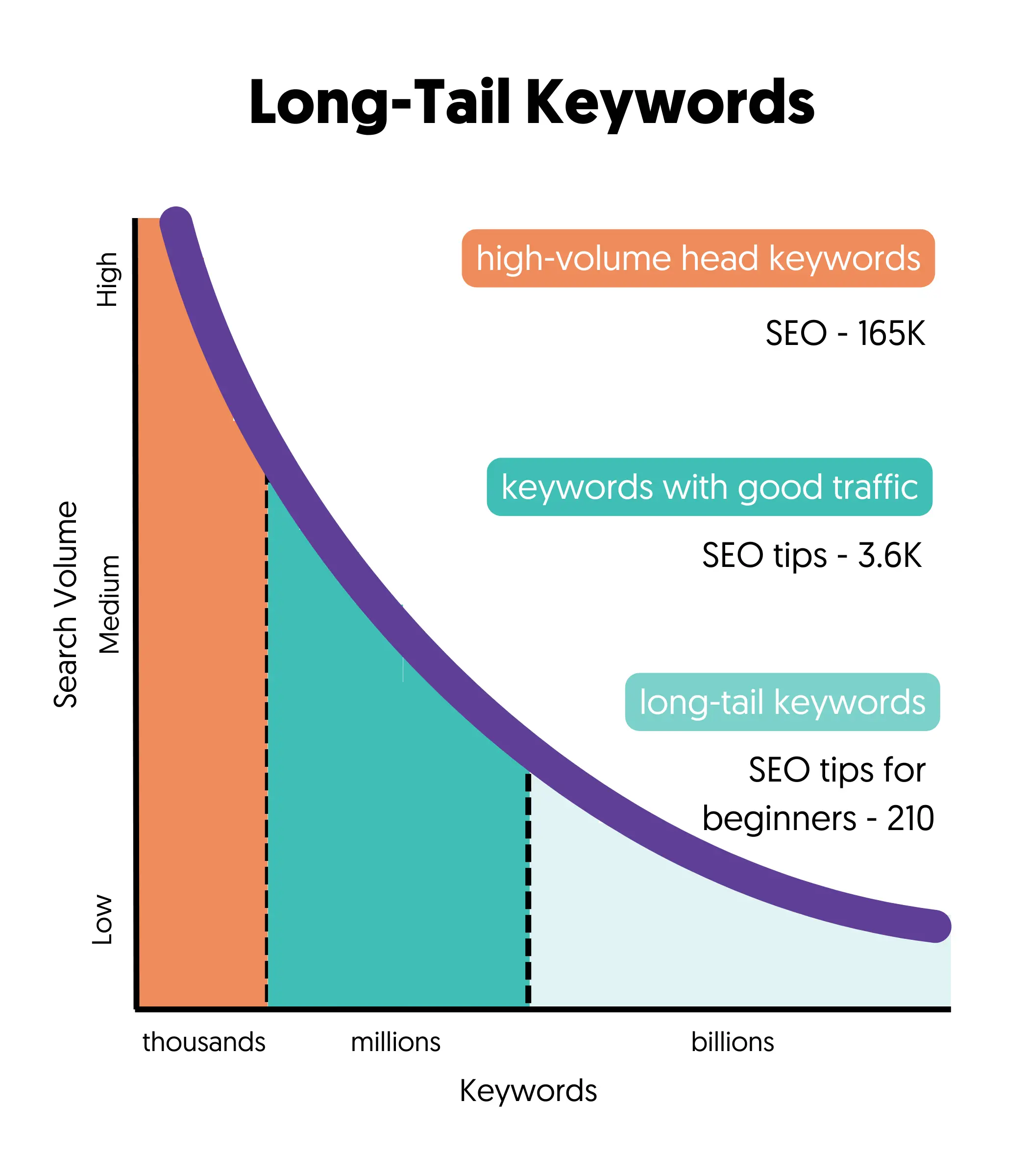
To find the right keywords, you can use tools like Google Keyword Planner, Ahrefs, or Semrush. These tools can provide information about keywords like search volume, difficulty levels, and user intent.
By the end of this step, you should have a list of keywords:
- That you can realistically rank for.
- Related to what your audience is looking for online.
- Related to your products and services.
3. Analyze and Learn from Your SEO Competitors
Your competitors can be one of your best resources for improving your SEO. By analyzing the websites already ranking for your target keywords, you can uncover what’s working in your niche and apply those insights to your own strategy.
Start by searching Google for your main keywords and noting the top-ranking websites. These are your direct SEO competitors. These sites are already attracting the audience you want.
To dive deeper, use the Google site search operator to explore their content library. For example, typing site:example.com “your keyword” into Google will show all indexed pages from that website related to your topic. This helps you understand how extensively they cover the subject.
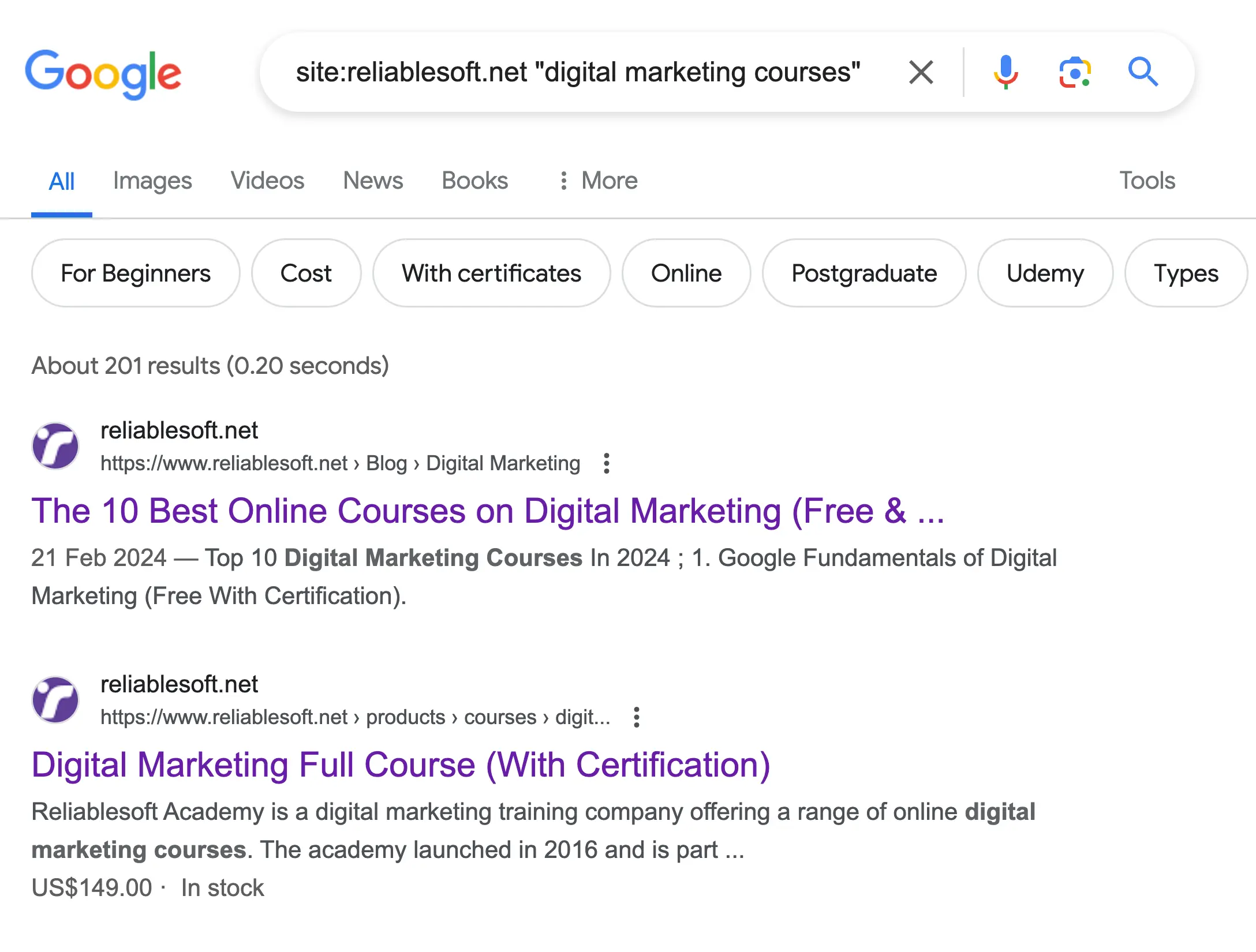
Once you’ve identified key competitors, analyze their SEO strategies using tools like Semrush or Ahrefs. Here’s what to look for when doing an SEO competitor analysis:
- Find their most visited pages and see what topics and keywords they focus on.
- Check where their backlinks come from. If they’re getting links from certain blogs or industry sites, you can reach out to those same sources for backlinks.
- Look at how they format their content. Do they use long-form blog posts? FAQs? Step-by-step guides?
- Examine their title tags, meta descriptions, and heading structure.
4. Design a User-Friendly Site Structure and Navigation
A well-structured website helps both users and search engines navigate your content easily. It improves user experience, boosts SEO, and ensures search engines can properly index your pages.
A good site structure is logical, simple, and easy to navigate. Every important page should be accessible in 3 clicks or less from the homepage.
Here is how it looks visually:
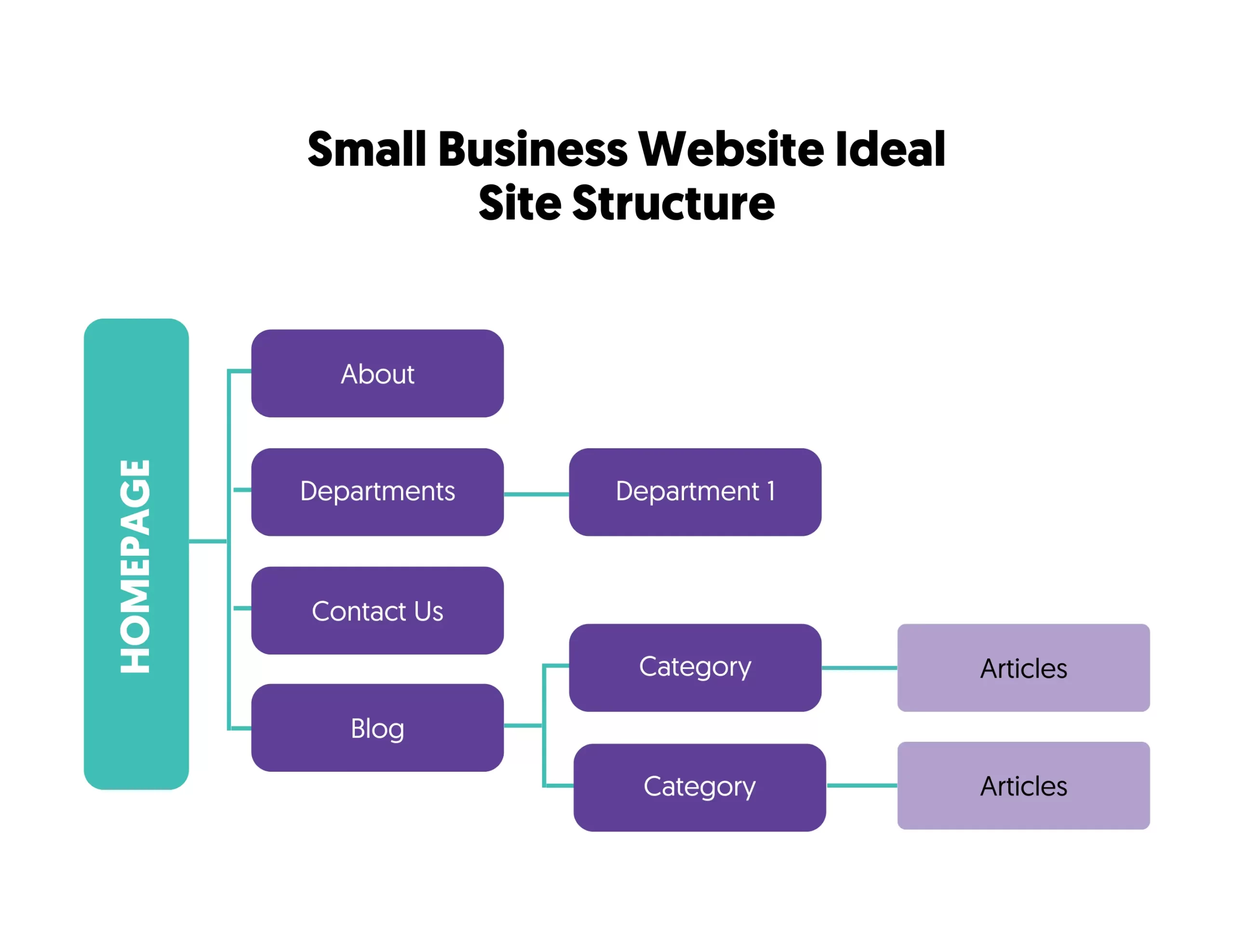
Here are some easy tips for building an effective site structure:
- Start by outlining your structure, and plan out essential pages like Home, About Us, Contact, Blog, and any key service or product pages.
- Group related content under clear, well-defined categories. For example, an eCommerce site might have categories like Men’s Shoes and Women’s Shoes, each leading to more specific product pages.
- Ensure your URL structure matches your site structure. For example, use yoursite.com/mens-shoes/running-shoes instead of yousite.com/running-shoes or yoursite.com/page124.
- Ensure your navigation menu includes all your main pages and categories.
5. Optimize Your Website’s Technical SEO
The next step is to work on technical SEO, which is the process of optimizing your website so that search engines can access it correctly.
Some of the most essential elements to consider are:
- Ensure that your robots.txt is not blocking search engine spiders from crawling and indexing your website.
- Register and authenticate your website with Google Search Console and Bing Webmaster tools.
- Create and optimize an XML sitemap and submit it to Google and Bing.
- Ensure that your permanent link structure (URLS) is SEO-friendly.
Most of the above tasks have one thing in common: you won’t have to deal with them again once you get them right from the beginning.
6. Develop a Strategic Content Marketing Plan
This is the most critical part of the process, and it will determine the success or failure of your website.
You need to develop a solid content marketing plan and, most importantly, follow it. Failing to do so will not yield results.
Content is the only way for a brand-new website to grow and gain more exposure in search engine result pages (SERPS).
The simplest way to start is by following these key steps:
- Define your core topics: Based on your keyword research and competitor analysis (steps 2 and 3), identify the main subjects your website will cover. These should align with what your target audience is searching for.
- Create a content calendar: Plan your content ahead of time. Decide on a posting frequency (e.g., 1-2 blog posts per week) and stick to a consistent schedule.
- Prioritize high-impact content first: Start with foundational content that answers common questions or provides essential information about your products or services.
- Mix content Types: Combine blog posts, guides, infographics, videos, and case studies to keep your content engaging and shareable.

7. Create High-Quality, SEO-Optimized Content
The next step is to familiarize yourself with the basic content writing and on-page SEO techniques. Since you are starting now, publishing good content and getting your on-page SEO correct will save you a lot of optimization time in the future.
What you should do is the following:
Publish useful and relevant content only: Every page or blog post published on your website should serve a purpose. It should answer a question, solve a problem, or provide unique insights.
Publishing low-quality or off-topic content can hurt your website in the long run. Google’s algorithms have become smarter at detecting content that doesn’t provide real value. If your articles are stuffed with keywords, misleading, or poorly written, you risk losing rankings—or worse, getting penalized by Google.
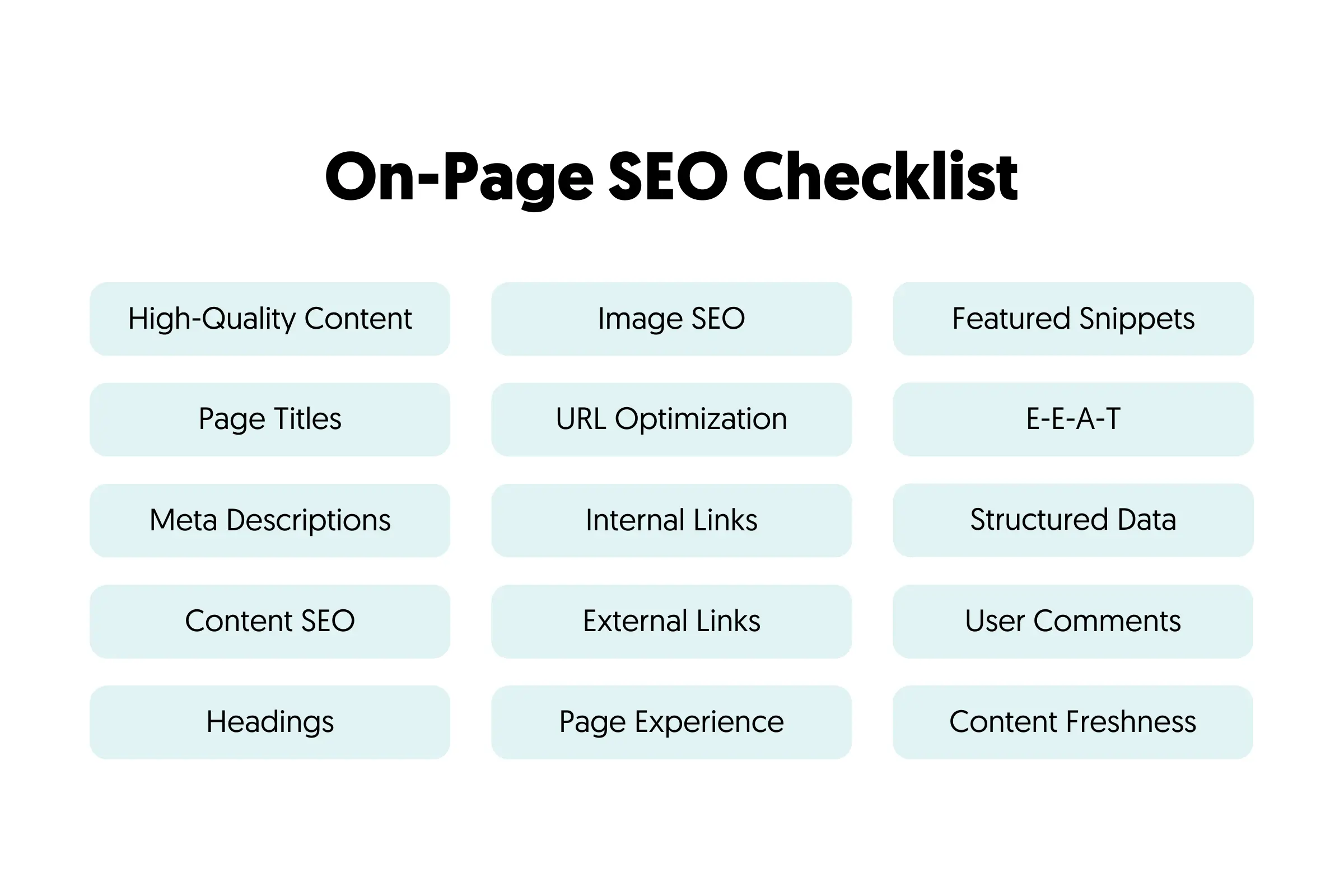
Optimize your content for SEO: Start by naturally integrating your target keywords in strategic places like the page titles, headings, first 100 words, and throughout the content.
Work on on-page formatting: Proper use of headings (H1, H2, H3), bullet points where necessary, and well-placed images with descriptive alt text make your content more accessible and appealing. Also, don’t forget meta descriptions—a well-written meta description can increase click-through rates from search results.
Finally, keep your content fresh. Google prefers updated, relevant content, so regularly revising older posts, adding new insights, and improving outdated information will help maintain your rankings.
High-quality, optimized content is a long-term investment, but if done right, it will continuously drive traffic and grow your website’s authority.
8. Build an Engaged Community Around Your Brand
Google loves brands. Websites that establish themselves as recognizable, trusted brands tend to rank higher and perform better in search results.
The more people engage with your brand through searches, social media, email, and discussions, the more signals Google receives that your website is valuable.
Your priority should be to start building a community around your brand. This means attracting an audience that actively interacts with your content, subscribes to your newsletter, follows you on social media, and engages in discussions.
Here are some tips for new websites:
The first step is capturing emails. Your email list is a direct line of communication with your audience. Use a tool like MailChimp or Kit to collect email addresses and send updates, promotions, or exclusive content.
Don’t just ask people to sign up—give them an incentive, such as a free ebook, checklist, or discount.
Place signup forms strategically throughout your site: in the header, sidebar, content, and exit popups to maximize visibility. If your budget allows, you can also use Facebook Lead Ads to grow your list faster.
Create a Facebook business page and Twitter account (at a minimum) and post regularly. Share your latest blog posts, industry insights, and engaging questions to encourage interaction. Don’t hesitate to use Facebook Paid Ads to gain followers or boost important posts to a targeted audience.
Search for your brand name on Google (use quotes like “reliablesoft”) and engage in discussions where people mention you. Tools like SEMrush’s Brand Monitoring feature can help track brand mentions across the web. This allows you to respond to feedback, correct misinformation, and reinforce your authority.
Analyze visitor behavior using Google Analytics. Identify and optimize pages with a high bounce rate (where users leave quickly). If visitors aren’t staying, they’re not becoming part of your community. Improving content, adding internal links, and enhancing user experience can help keep them engaged.
Building a community takes time, but the stronger your brand presence, the better your SEO results.
9. Boost Visibility with Off-Page SEO and Promotion
Once you have the above in place and you manage to execute your content marketing plan without delays, you will reach a point where:
- Your website will grow bigger in terms of published content
- Your subscriber list will have more members
- Your social media pages will have more followers
- You will start getting repeating visitors
- You will notice that you have several pages ranking in the second and third pages of Google (with some exceptions that will rank on page one).
This is a great position to be in and a good sign that you are in the right direction.
But, if you want to get to the next level and increase all of the above, including your rankings and traffic, you need to start spending time promoting your website.
By promoting, I mean starting with off-page SEO.
Off-page SEO is a general term that refers to all activities that can improve a website's ranking position in the SERPs (Search Engine Results Pages).
The most valuable and effective technique of Off-Page SEO is link building.
Link building has four primary characteristics:
- It is challenging to master, especially at the beginning
- It is time-consuming to execute
- It takes time to get results
- Doing it wrong can do more harm than good (think Google penalties and rankings loss).
So, if this is the case, what should you do?
The best way to approach link building (for a new website on a limited budget) is the following:
First, familiarize yourself with what link building is and is not.
If you search Google for “link-building techniques” (or similar keywords), you may end up following advice that is wrong or unsuitable for your website, and the results will be catastrophic.
Second, start slow and gradually make your link profile stronger.
Here is a solid plan to follow:
- Aim to get links from websites with more content than yours and more traffic that are closely related to your niche.
- Create link-worthy content before going out and asking for links or hoping that you will get natural links.
- Don’t believe what they say that any link is a good link. It does not matter how many links you have pointing to your website, but it’s about where those links come from.
- A few links from highly trusted websites are far more valuable than 100 links from low-trusted sources.
- When applying to guest posts on other websites, you need to be able to show them examples of your published work (besides your website), so get ready for this in advance.
- LinkedIn Long-form posts, Medium, and other free platforms are a good place to start (even if the links are ‘nofollow’).
- Build your link profile slowly but steadily. Don’t try to get tens of many links from the beginning (it doesn’t look natural), but try to get them slowly but steadily.
- Connecting with other bloggers (especially the influencers in your niche) may get you precious links.
- Don’t be afraid to link to other websites when you believe that doing so will help your readers. Linking out is a great way to get noticed by other bloggers (including influencers) in your niche.
10. Track Performance, Analyze Data, and Improve Continuously
To ensure your website grows and ranks higher, you must track and analyze your SEO results.
Without monitoring your performance, you won’t know what’s working, what needs adjustment, or where new opportunities exist.
Start by setting up Google Analytics and Google Search Console to track key SEO metrics like organic traffic and keyword rankings.
Identify which pages are attracting visitors and which ones are underperforming. If specific pages have low engagement rates or rankings, improve their content, design, or internal linking to keep users engaged.
Conclusion
Doing SEO for a new website is not as hard as it sounds. Yes, it will take time and effort for SEO to work, but it’s a necessary first step that will generate several other benefits in the future.
What you have read above doesn’t cost much money to implement. If you have the right skills and knowledge, it’s a job you can do on your own.
Nevertheless, if you don’t have the right skills to optimize your website for Search Engines, the recommended first step is to build your skills to utilize your time better and allocate it to the tasks that matter and can bring results.
Various SEO training courses are available, which are low-cost solutions that can help you master the basic and advanced SEO features.

